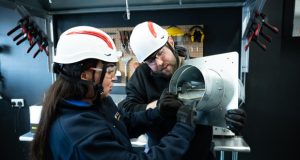Britain is facing a huge increase in Legionnaires’ disease that is being fuelled by climate change, water hygiene experts warn.
The problem is a growing headache for landlords and health and safety professionals who have a legal duty to ensure that water supplies are safe.
The potentially fatal illness is spread via the legionella bacteria, which thrives within a specific temperature range in water systems.
Met Office figures published in January 2020 show that the previous decade was the second hottest of the last 100 years. Meanwhile, confirmed cases of Legionnaires’ disease in the UK over the period rose by approximately 38 per cent.
Water hygiene engineer Joe Finn and technology expert Florin Mangu, whose company Remote Tech develops smart systems to monitor risk of legionella, believe the climate change statistics represent a potential time tomb.
Finn said: “Legionella thrives within a warm range of temperatures, so the latest climate change figures make grim reading. We have seen a huge increase in confirmed cases of Legionnaires’ disease. If this continues we face a potential time bomb, with the threat to public health from Legionnaires’ disease likely to further escalate. It’s a particularly nasty form of pneumonia, with the young and elderly among those most at risk.”
Legionella can survive within a temperature range broadly between 20 and 50 degrees C – and proliferate in just 24 hours if water temperatures are around 37.5 degrees C for the bug to multiply. If inhaled into the lungs via water droplets it causes Legionnaires’ disease. During a major outbreak, around 10 per cent of cases can be fatal.
The UK experienced its highest ever temperature last year when 38.7 degrees C was recorded in Cambridge on 25 July. Three other records were set across the UK: these included the hottest ever days in the months of February and December, plus the highest daily minimum in February.
There are similar trends across Europe, where The Institute for Hygiene and Public Health at University Clinic Bonn recently stated that climate change is likely to be contributing to an increase in pneumonia caused by legionella. Meanwhile, a viral video of temperature graphics posted online recently showed the stark increases in warm temperatures in cities around the globe.
Traditionally, water systems in public buildings have been subject to monthly temperature tests, which are taken manually. However, Remote Tech has developed a smart sensor that uses ‘internet of things’ technology to remotely monitor water systems for risk of legionella.
When temperatures are normal the sensor remains on standby, hence saving on battery power. But if temperatures change, it awakes and sends an alert. The device removes the need for regular site visits, hence reducing carbon footprints.
It is currently undergoing extensive trials in conjunction with a number of large institutions and commercial companies.





